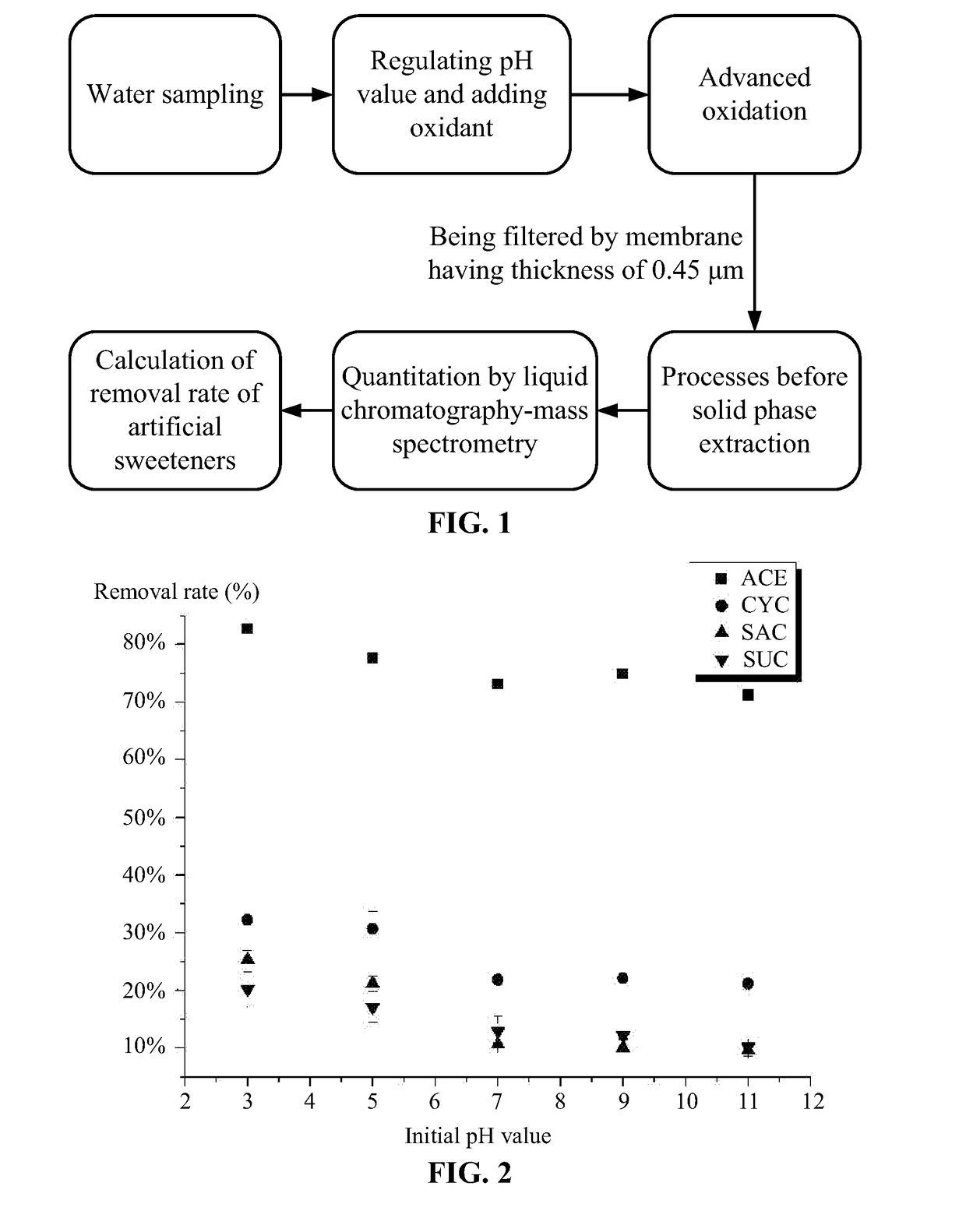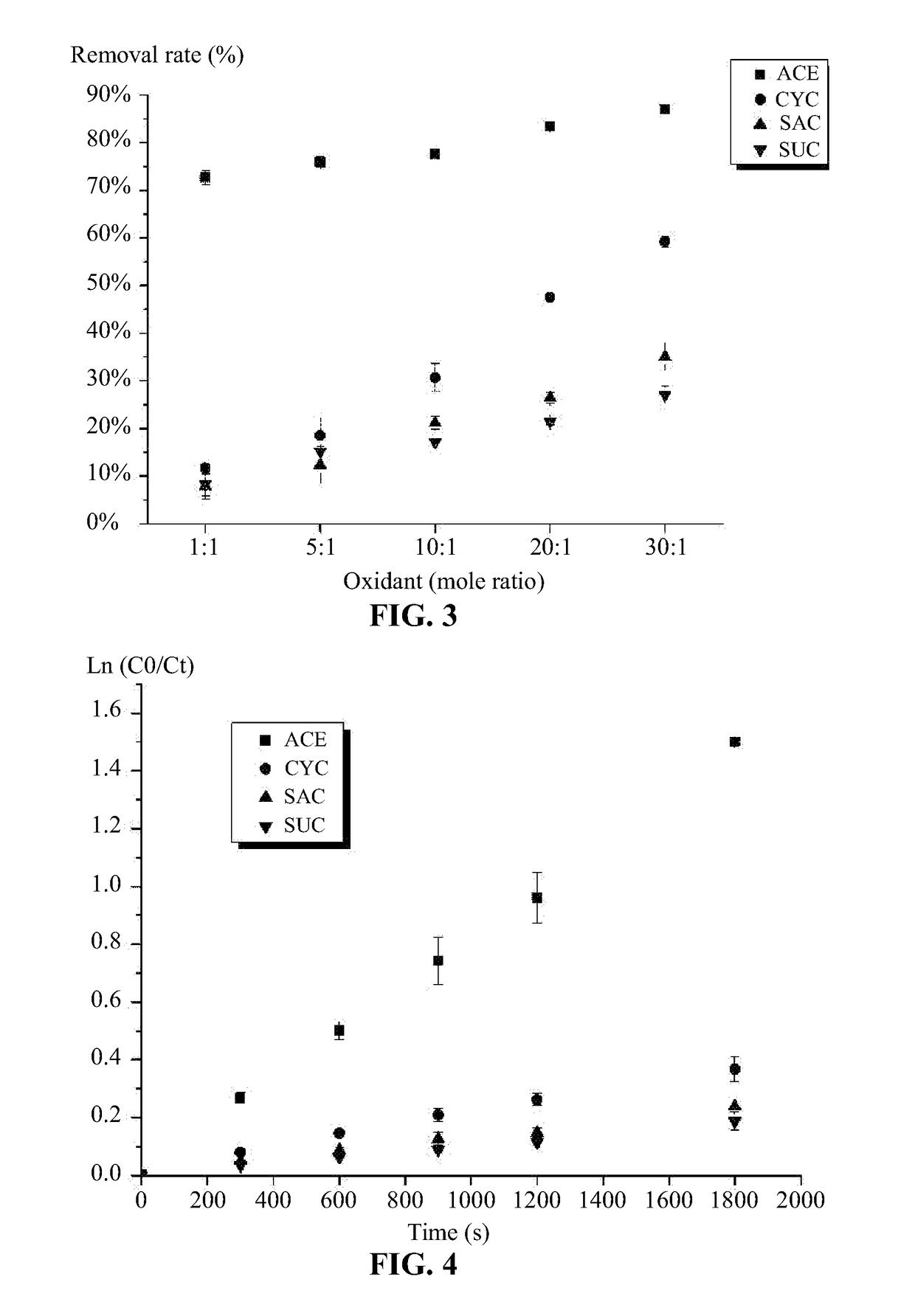Method for degrading artificial sweeteners from sewage
- Summary
- Abstract
- Description
- Claims
- Application Information
AI Technical Summary
Benefits of technology
Problems solved by technology
Method used
Image
Examples
example 1
[0024]Secondary biological effluent from a municipal sewage treatment plant in Nanjing was taken as an example. A method for degrading artificial sweeteners from sewage by advanced oxidation processes was conducted as follows:
[0025]1) Sewage was introduced to a secondary sedimentation tank under the action of gravity to precipitate sediments of the sewage in the secondary sedimentation tank.
[0026]2) A supernatant was collected from the secondary sedimentation tank and added with a NaOH solution or a perchloric acid solution as a pH regulator to regulate a pH value of the supernatant to be between 3 and 11. A concentration of the NaOH solution or the perchloric acid solution was 0.5 mol / L. Thereafter, a 30% w / w aqueous H2O2 solution was added to the supernatant to adjust a ratio of a molar concentration of H2O2 to a molar concentration of the sweetener in a resulting mixed solution to be 10:1. The resulting mixed solution was transferred to a photoreactor for photoreaction, during wh...
example 2
[0028]Secondary biological effluent from a municipal sewage treatment plant in Nanjing was taken as an example. A method for degrading artificial sweeteners from sewage by advanced oxidation processes was conducted as follows:
[0029]1) Sewage was introduced to a secondary sedimentation tank under the action of gravity to precipitate sediments of the sewage in the secondary sedimentation tank.
[0030]2) A supernatant was collected from the secondary sedimentation tank and added with a NaOH solution or a perchloric acid solution as a pH regulator to regulate a pH value of the supernatant to be 5. A concentration of the NaOH solution or the perchloric acid solution was 0.5 mol / L. Thereafter, a 30% w / w aqueous H2O2 solution was added to the supernatant to adjust a ratio of a molar concentration of H2O2 to a molar concentration of the sweetener in a resulting mixed solution to be between 1:1 and 30:1, in the meanwhile, active carbon fibers according to an addition of 150 mg / L were added. A ...
example 3
[0032]Secondary biological effluent from a municipal sewage treatment plant in Nanjing was taken as an example. A method for degrading artificial sweeteners from sewage by advanced oxidation processes was conducted as follows:
[0033]1) Sewage was introduced to a secondary sedimentation tank under the action of gravity to precipitate sediments of the sewage in the secondary sedimentation tank.
[0034]2) A supernatant was collected from the secondary sedimentation tank and added with a NaOH solution or a perchloric acid solution as a pH regulator to regulate a pH value of the supernatant to be 5. A concentration of the NaOH solution or the perchloric acid solution was 0.5 mol / L. Thereafter, a 30% w / w aqueous H2O2 solution was added to the supernatant to adjust a ratio of a molar concentration of H2O2 to a molar concentration of the sweetener in a resulting mixed solution to be 10:1. The resulting mixed solution was transferred to a photoreactor for photoreaction, during which, the mixed ...
PUM
 Login to View More
Login to View More Abstract
Description
Claims
Application Information
 Login to View More
Login to View More - R&D
- Intellectual Property
- Life Sciences
- Materials
- Tech Scout
- Unparalleled Data Quality
- Higher Quality Content
- 60% Fewer Hallucinations
Browse by: Latest US Patents, China's latest patents, Technical Efficacy Thesaurus, Application Domain, Technology Topic, Popular Technical Reports.
© 2025 PatSnap. All rights reserved.Legal|Privacy policy|Modern Slavery Act Transparency Statement|Sitemap|About US| Contact US: help@patsnap.com


